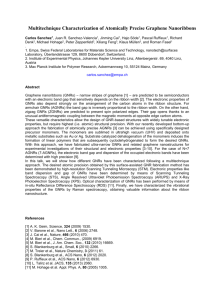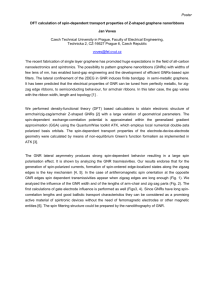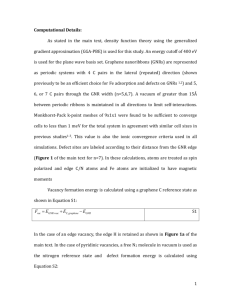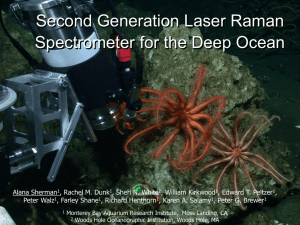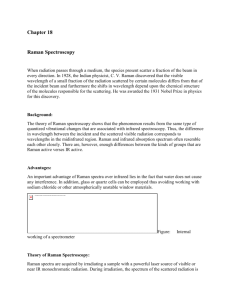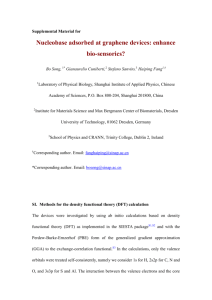Supplementary_Information_3rdsub_PRL
advertisement
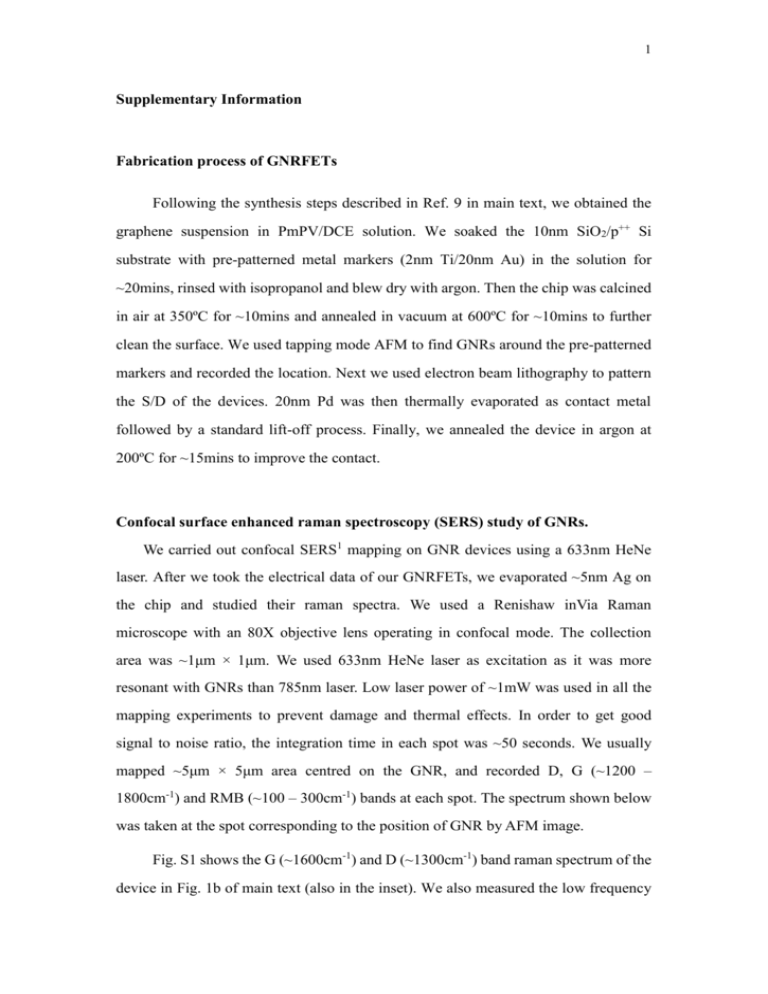
1 Supplementary Information Fabrication process of GNRFETs Following the synthesis steps described in Ref. 9 in main text, we obtained the graphene suspension in PmPV/DCE solution. We soaked the 10nm SiO2/p++ Si substrate with pre-patterned metal markers (2nm Ti/20nm Au) in the solution for ~20mins, rinsed with isopropanol and blew dry with argon. Then the chip was calcined in air at 350ºC for ~10mins and annealed in vacuum at 600ºC for ~10mins to further clean the surface. We used tapping mode AFM to find GNRs around the pre-patterned markers and recorded the location. Next we used electron beam lithography to pattern the S/D of the devices. 20nm Pd was then thermally evaporated as contact metal followed by a standard lift-off process. Finally, we annealed the device in argon at 200ºC for ~15mins to improve the contact. Confocal surface enhanced raman spectroscopy (SERS) study of GNRs. We carried out confocal SERS1 mapping on GNR devices using a 633nm HeNe laser. After we took the electrical data of our GNRFETs, we evaporated ~5nm Ag on the chip and studied their raman spectra. We used a Renishaw inVia Raman microscope with an 80X objective lens operating in confocal mode. The collection area was ~1μm × 1μm. We used 633nm HeNe laser as excitation as it was more resonant with GNRs than 785nm laser. Low laser power of ~1mW was used in all the mapping experiments to prevent damage and thermal effects. In order to get good signal to noise ratio, the integration time in each spot was ~50 seconds. We usually mapped ~5μm × 5μm area centred on the GNR, and recorded D, G (~1200 – 1800cm-1) and RMB (~100 – 300cm-1) bands at each spot. The spectrum shown below was taken at the spot corresponding to the position of GNR by AFM image. Fig. S1 shows the G (~1600cm-1) and D (~1300cm-1) band raman spectrum of the device in Fig. 1b of main text (also in the inset). We also measured the low frequency 2 band (100 ~ 300cm-1) of our GNR devices, but never observed any RBM peak in that region, which appeared to be the main difference between GNRs and carbon nanotubes (CNTs)2. In the G band, some GNRs showed triplet structure, with the main peak located ~1580-1590cm-1, a hump like peak in lower energy, whose frequency depends on the widths of the GNRs, and a weak higher frequency peak ~1610cm-1. The splitting of G peak is due to phonon confinement in the width direction, as in the case of CNTs2-4. Interestingly, for this particular GNR, the splitting between the main peak and lower frequency peak is ~55cm-1, close to that of d~0.9nm (~3nm circumference, close to GNR width) semiconducting CNTs5. The D band intensity of some of the GNRs is high likely due to the edges, which is the main source of D band in large graphene6-8. The D and G bands of GNRs are broader than those in CNTs and bulk graphene. The relatively high D peak intensity and broadening of D and G peaks suggest the presence of sp2 bond disorders6,9, most likely on edges. Detailed raman study of these narrow GNRs is submitted separately2. Figure S1. G and D bands raman spectrum (symbol) of the device in Figure 1b in main text. Red line shows the fit of G band using three Lorentzians (green lines). The peak positions (full widths at half maximum) are at 1529cm-1 (70cm-1), 1584cm-1 (36cm-1) and 1614cm-1 (20cm-1, indicated by an arrow). Inset is the AFM image of this device. 3 Calculation of gate capacitance We used Fast Field Solvers (available at http://www.fastfieldsolvers.com) for three dimensional simulation of Cgs. The simulated structure included a large back plane as backgate, a dielectric layer with same lateral dimension of backgate, 10nm thickness and 0 =3.9, a graphene layer with experimental dimension lying ~0.5nm above the dielectric layer (note that the 0.5nm separation has little effect in calculated Cg) and two metal fingers with experimental dimension to represent contacts. In order to get precise result, rather fine grids are used in simulation (~1nm for GNR). Modelling edge scattering mfp in GNRs The first conduction subband E-k relation of a semiconducting GNR can be approximately expressed as, E (k ) 3ta0 2 k||2 k 2 , where t is the nearest neighbour hopping parameter, a0 is the C-C bonding length, k|| is the component of the wave vector k in transport direction, and k is the component in the confinement direction. The E-k relation yields a half band gap of 3ta0 k / 2 and a carrier kinetic energy of Ek E (k ) . Under the semiclassical description, a distance of wk|| / k is travelled along the transport direction between two turns in the zigzag path of the carrier. If the backscattering probability is assumed to be P, which depends on the quality of the edges, the edge backscattering mfp is edge k|| w / k P . 2 By substituting Ek and Δ into this equation, we obtain edge w Ek 1 1 . This P expression indicates that the increase of the GNR width or carrier kinetic energy, and 4 the improvement of the GNR edge quality can lead to an increase of the edge backscattering mfp. The above derivation were based on the simplified assumptions of an approximate E-k relation and a semiclassical approach, but the quantum simulation based on an atomistic simulation of a GNR with edge roughness using the non-equilibrium Green’s function (NEGF) formalism with a numerical extraction of the mfp indicates that the above equation provides a simple and valid estimation of the edge backscattering mfp. Fabrication and performance of CNTFETs. The CNTs were grown by patterned CVD on 10nm SiO2/p++ Si substrate. Ebeam lithography was used to write S/D followed by Pd evaporation and lift-off. Devices were then annealed 200ºC in argon for 15mins to improve contact and probed to get electrical data. Fig. S2 shows the transfer characteristics and AFM images of the devices used in Fig. 4b of main text. 5 -5 (a) 10-5 (b) 10 -6 10 -6 -7 -7 -Ids(A) -Ids(A) 10 10 -8 10 8_4B11up -1mV, -10mV, -100mV, -500mV -9 10 10 -8 10 -9 10 8_4B11mid -1mV, -10mV, -100mV, -500mV -10 10 -11 10 -10 10 -2 -1 -5 0 Vg (V) 1 2 (c) 10 -2 -1 0 Vg (V) 1 2 1 2 (d) -6 10 -7 10 -7 -8 -Ids(A) -Ids(A) 10 10 -9 10 8_4E8up -1mV, -10mV, -100mV, -500mV -10 10 -11 -9 10 -11 8_1B6mid -1mV, -10mV, -100mV, -500mV 10 10 -12 10 -13 -2 -1 0 Vg (V) 1 2 10 -2 -1 0 Vg (V) Figure S2. Transfer characteristics of CNTFETs. Drain bias Vds=-1mV, -10mV, -100mV and -500mV for blue, green, orange and red curves, respectively. The insets are corresponding AFM images. (a) d~1.6nm L~102nm. (b) d~1.6nm L~254nm. (a) d~1.3 nm L~110nm. (a) d~1.1nm L~254nm. Refernces: 1. Kumar, R., Zhou, H. & Cronin, S.B. Surface-enhanced Raman spectroscopy and correlated scanning electron microscopy of individual carbon nanotubes. Appl. Phys. Lett. 91, 223105 (2007). 2. Gupta, A., Wang, X., Li, X., Dai, H. & Eklund, P. Polarized raman scattering from narrow graphene ribbons. In preparation. 3. Dresselhaus, M.S., Dresselhaus, G., Saito, R. & Jorio, A. Raman spectroscopy of carbon nanotubes. Phys. Rep. 409, 47 (2005). 4. Dresselhaus, M.S. et al. Raman spectroscopy on isolated single wall carbon nanotubes. 6 Carbon 40, 2043 (2002). 5. Jorio, A. et al. G-band resonant Raman study of 62 isolated single-wall carbon nanotubes. Phys. Rev. B 65, 155412 (2002). 6. Ferrari, A.C. Raman spectroscopy of graphene and graphite: disorder, electron-phonon coupling, doping and nonadiabatic effects. Solid State Comm. 143, 47 (2007). 7. Ferrari, A.C. et al. Raman spectrum of graphene and graphene layers. Phys. Rev. Lett. 97, 187401 (2006). 8. Casiraghi, C. et al. Raman fingerprint of charged impurities in graphene. Appl. Phys. Lett. 91, 233108 (2007). 9. Ferrari, A.C. & Robertson, J. Interpretation of Raman spectra of disordered and amorphous carbon. Phys. Rev. B 61, 14095 (2000).



